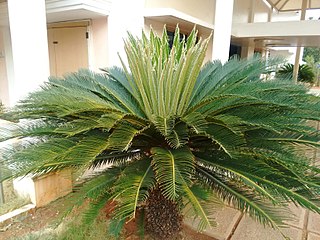
Cycas is a genus of plants belonging to a very ancient lineage, the Cycadophyta, which are not closely related to palms, ferns, trees or any other modern group of plants. They are evergreen perennials which achieved their maximum diversity in the Jurassic and Cretaceous periods, when they were distributed almost worldwide. At the end of the Cretaceous, when the non-avian dinosaurs became extinct, so did most of the cycas in the Northern Hemisphere.

Asteromyrtus is a genus of flowering plants in the Myrtaceae family. Asteromyrtus was described as a genus in 1843. It is closely related to Callistemon and Melaleuca. The genus was subsequently subsumed into Melaleuca and Sinoga, but was reinstated by Lyndley Craven in 1988 to accommodate seven species, all of which are tropical shrubs or small trees native to New Guinea, Maluku, or northern Australia.
- Asteromyrtus angustifolia - N Queensland
- Asteromyrtus arnhemica - N Northern Territory, N Western Australia
- Asteromyrtus brassii - S New Guinea, N Queensland
- Asteromyrtus lysicephala - S New Guinea, N Queensland
- Asteromyrtus magnifica - N Northern Territory
- Asteromyrtus symphyocarpa – liniment-tree - S New Guinea, N Queensland, N Northern Territory
- Asteromyrtus tranganensis - Aru Islands in Maluku
Bambusa arnhemica is one of three bamboo species native to Australia. It grows in the northwestern areas of the Northern Territory, and is common on riverbanks in Kakadu. Stems turn orange yellow as they harden. Upper stems and branches arch gracefully. It grows to about 8 m in height. It is available from specialist nurseries.
Cycas arnhemica is a species of cycad in the genus Cycas, native to Australia, in the northwest of Northern Territory in Arnhem Land, after which it is named.

Platysace is a genus of woody perennial herbs and subshrubs in the family Apiaceae. The genus is endemic to Australia.
Utricularia arnhemica is an affixed aquatic or terrestrial carnivorous plant that belongs to the genus Utricularia. It is endemic to the Arnhem Land area in the Northern Territory of Australia.

Ammannia gracilis is a species of flowering plant in the family Lythraceae. It is native to Africa.

Ammannia is a genus of around 100 species of plants often referred to as redstems from wet areas in America, Africa, Asia, Australia and Europe. Several species are grown as decorative plants in aquariums.

Ammannia robusta is a species of flowering plant in the loosestrife family known by the common name grand redstem. It is widespread across much of North America with additional populations in southeastern Brazil.
A. gracilis may refer to:

Ammannia baccifera, also known as the monarch redstem or blistering ammannia is a species in the family Lythraceae. It is widespread in the tropical regions of Asia, America and Africa. It has been naturalized in Spain. It is annual and herbaceous, and can be found in marshes, swamps, rice fields and water courses at low elevations. It is considered endangered in Israel, but because it is widespread and common elsewhere, the IUCN considers it to be 'Least Concern'. The plant Ammannia baccifera Linn. is erect, branched, smooth, slender, annual, more or less purplish herb 10 to 50 centimeters in height. The stems are somewhat 4-angled. The leaves are oblong, oblanceolate, or narrowly elliptic, about 3.5 centimeters long – those on the branches very numerous, small, and 1 to 1.5 centimeters long – with narrowed base and pointed or somewhat rounded tip. The flowers are small, about 1.2 millimeters long, greenish or purplish, and borne in dense axillary clusters. The capsules are nearly spherical, depressed, about 1.2 millimeters in diameter, purple, and irregularly circumscribes above the middle. The seeds are black.

Ammannia multiflora, commonly known as many-flower ammannia and jerry-jerry in Victoria, is a species in the family Lythraceae. It is widespread in Asia, tropical and sub-tropical Africa and Australia. It can be found in shallow water and damp heavy soils.
Ammannia auriculata, commonly known as eared redstem, is a species in the family Lythraceae that is found in tropical and subtropicalt areas around much of the world.
Ammannia crinipes is a species in the family Lythraceae that is endemic to northern Australia.
Ammannia fitzgeraldii is a species in the family Lythraceae that is endemic to northern Australia.
Ammannia muelleri is a species in the family Lythraceae that is endemic to northern Australia.
Ammannia striatiflora is a species in the family Lythraceae that is endemic to northern Australia.
The East Arnhem land gehyra is a species of gecko. It is endemic to Northern Territory in Australia.
Asteromyrtus arnhemica is a species of plant in the myrtle family Myrtaceae that is native to northern Australia.







